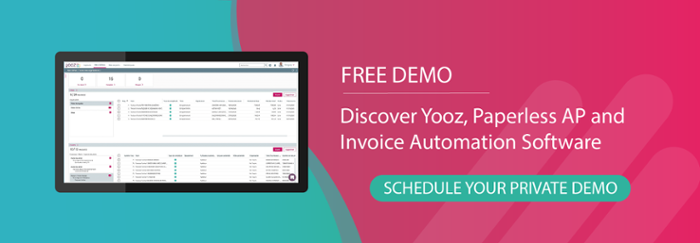Tired of delays and additional costs in your Accounts Payable (AP) invoice processing workflow? Are you looking for a way to streamline your processes and save money? Taking advantage of Accounts Payable automation with a paperless invoice processing system could be the ideal solution.
Managing the Accounts Payable invoice process is one of the most crucial aspects of running a business, directly affecting profitability and operations throughout the entire organization. It ensures that suppliers and creditors are paid, invoices are processed and approved, and all relevant data is recorded. By doing all these in a timely manner it also helps to establish and maintain good relationships with suppliers while simultaneously preventing errors and fraud.
In other words, an optimized AP workflow is key to any company staying competitive and successful.
AP process challenges
The AP process has historically been manual and heavily paper based all the way from purchase through payment. While parts have gradually adapted to advances in technology (think desktop accounting software packages or Excel spreadsheets), most remain outdated practices that can create challenges for any company wanting efficient, optimized system in place. For example, poorly defined and paper-based invoice processing typically leads to issues such as:
- Slow processing,
- Matching errors,
- Extra work (manual follow-ups for exceptions such as for incomplete or incorrect data),
- Lost invoices or records, and
- Double payments.
In addition, research has shown that management priorities and competing budget demands, IT availability, and lack of staff resources were also blockers of automation.
For anybody facing any of these challenges, using a technology tool like automation - a paperless invoice processing system - could be the solution.
What is a paperless invoice processing system?
To understand the benefits of an Accounts Payable paperless workflow, it is necessary to understand what that means. Paperless invoice processing is exactly what it says: an automated workflow that eliminates paper-based processes - and the manual tasks that go with it - from your AP process.
Eliminating the need for physical documents makes the Accounts Payable process easier and more efficient, reducing costs and increasing the visibility and accuracy of financial operations. It also provides a digital trail for tracking and audit purposes and a centralised (digital) storage location. And are these advantages being noticed?
The answer is yes. In today’s age of digital transformation, this is where management teams seem to be turning for AP workflow modernization. In fact, according to the Digital Transformation Survey report by PTC, 70% of organizations have a digital transformation strategy or are working on one.
The benefits of automating your AP workflow
What makes digital transformation and Accounts Payable automation systems so popular? The advantages and benefits. These include:
- More speed and accuracy compared to manual entry, accelerating the approval process and reducing human errors that result in disputes or corrections.
- Having a single, centralised storage for all related data that can be accessed 24/7 from anywhere. This includes a digital audit trail that lets you know the status of any invoice at the touch of a button.
- Reducing overhead costs related to office space for paper storage, filing, mailing, printing, and even outsourced (processing) labor.
In addition, automating an AP workflow means everything from simplified compliance requirements (think MTD!) to increasing financial visibility and more efficient data management for information analysis. All for better control over operations and any strategic decision-making.
Any size business can benefit from going paperless
Historically cost has been a major factor in the ability to access and use modern technology. Thanks to modern cloud-based SaaS platforms, this is no longer the case. Now any size business can benefit from a Accounts Payable paperless invoice workflow – not just large corporations with sizeable budgets.
In fact, smaller businesses tend to have even more opportunities for cost savings because they have fewer resources available to dedicate to managing manual accounts payable processes such as entering and checking invoice data or searching through folders full of document records. The same applies to larger organisations where resources can be better allocated instead of handling repetitive, tedious processes.
Converting the AP workflow from manual to paperless
When converting your existing Accounts Payable workflow from manual to paperless, there are several steps to consider.
First, determine the solution that best suits your needs. Some of the ways that you can do this are by assessing which tasks need automation most urgently, analysing costs versus ROI, and talking with internal users and experts. Also, compare available market solutions, speak with outside experts, and even check out what the competitors are doing.
Second, evaluate whether any new processes will need to be put in place such as adding electronic payment and banking solutions or integrating systems with the existing company IT systems.
Finally, establish a training program for employees so that everyone involved knows how to use the new system properly. Ensuring that employees both understand and are comfortable with the system is a key step to ensuring the success of any new processes. It also helps to open the door to additional digitalisation efforts in other departments.
An experienced third-party vendor can help you successfully navigate all of these steps and more. For example, Yooz offers real-time, cloud-based AP automation knowledge based on experience with over 4,000 customers and 10,000 companies worldwide, as well as native integration with 250+ Enterprise Resource Planning (ERP) systems.
Take advantage of existing paperless Accounts Payable best practices
There are some important best practices that should be followed when implementing a paperless invoice process:
- Ensure automated controls are in place and secure access levels, especially for personnel dealing with sensitive data.
- Create rules and procedures for internal control audits.
- Automate approvals and escalations wherever possible.
- Implement regulation-based rules for archiving digital documents.
- Review invoice data regularly and note the number of errors or exceptions caught by the system. What type are they? Does it appear accidental or an attempt at fraud?
- Verify supplier data to ensure that it is kept accurate and up to date.
After all, there is truth to the saying that “technology is only as good as the people who operate it.”
What to conclude
By following these tips when creating an accounts payable paperless workflow, you can help ensure that the process runs smoothly and efficiently, enjoying all the advantages of going paperless without compromise.








